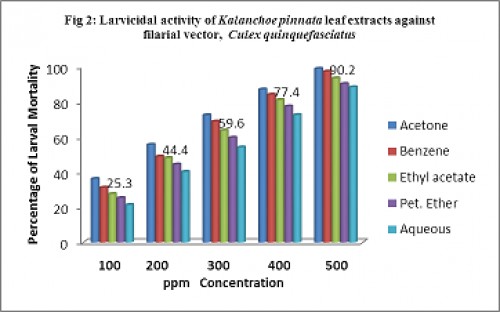Vol. 4, Issue 2, Part B (2017)
Evaluation of ovicidal and larvicidal potential of Kalanchoe pinnata leaf extracts against filarial mosquito vector, Culex quinquefasciatus
Author(s): A Rajesh and Dr. Mohamed Shamsudin
Abstract: Mosquito-borne diseases have an economic impact, including loss in commercial and labor outputs, particularly in countries with tropical and subtropical climates; however, no part of the world is free from vector-borne diseases. Vector borne diseases are major sources of illness and death worldwide. Mosquitoes are primary vectors for many dreadful and fatal diseases. Culex quinquefasciatus is the principal vector of lymphatic/bancroftian filariasis and also a potential vector of several arboviruses. To prevent proliferation of mosquito-borne diseases and to improve quality of the environment and public health, mosquito control is essential. Plants enriched with phytochemicals are reported to possess insecticidal properties particularly mosquitocidal. Botanical origin may have the potential to controlling mosquito successfully nowadays. Therefore, in the present investigation was undertaken to evaluate ovicidal and larvicidal activities of crude acetone, benzene, ethyl acetate, petroleum ether and aqueous extracts of Kalanchoe pinnata leaf were assayed for their toxicity against filarial vector mosquito, Culex quinquefasciatus. The rates of mortality were directly proportional to various concentrations ranging from 50-300 ppm for eggs and 100-500 ppm for fourth instar larvae of target vector mosquitoes under the laboratory conditions. The ovicidal and larvicidal activities were observed after 24 hours exposure. The mortality (eggs) was observed 100% at 250 ppm of the acetone extract, followed by benzene, ethyl acetate, petroleum ether and aqueous leaf extract exerting 100% mortality at the concentration of 300 ppm. The control eggs showed 100% hatchability. The results revealed that the acetone leaf extract of Kalanchoe pinnata showed the highest larvicidal (LC50 and LC90) activity than the other extracts. The highest larvicidal effect observed in the leaf acetone extract of Kalanchoe pinnata against Culex quinquefasciatus with the LC50 and LC90 values 199.86 and 387.70ppm respectively. This is the first report on the mosquito ovicidal and larvicidal activities of the reported Kalanchoe pinnata leaf.
Related Graphics: Click here for more related graphics

Fig.: Larvicidal activity of Kalanchoe pinnata leaf extracts against filarial vector, Culex quinquefasciatus
Pages: 142-147 | 2404 Views 333 Downloads
How to cite this article:
A Rajesh, Dr. Mohamed Shamsudin. Evaluation of ovicidal and larvicidal potential of Kalanchoe pinnata leaf extracts against filarial mosquito vector, Culex quinquefasciatus. Int J Mosq Res 2017;4(2):142-147.







